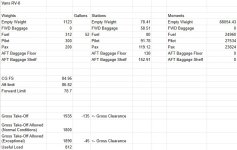aerialsasquatch
I'm New Here
Hey y'all! I'm a student pilot who has the (usually fortunate) current misfortune of also being 6'9" (and around 300lbs). This makes CG and MGW calculations for a lot of planes that I would love to love...a bit of a one sided relationship.
The RV-8 in particular has really stolen my eyes, and fits everything I'd want in a mission. Speedy, great range, fun high ceilings, aerobatic, and seems to have the ability (especially with potential finagling of seat angles and panel re-structuring) to accommodate my height super well.
W&B are a bit more suspect.
For example, I've grabbed a couple POHs from users who were kind enough to post to do some testing of W&B, and they don't look great, especially on the MGW portion.
For example, the attached (using numbers from Burke's N113DU POH) shows just myself, full fuel, and the pax, with zero baggage, and already we're over the recommended MGW and also sitting pretty far aft in the envelope (though within limits). Forward baggage helps (but not a ton) on the CG, but only makes the MGW violation even worse.
I really want a plane that doesn't always have an empty backseat, and I'm curious what experiences other tall and/or heavy pilots have, as well as the experience of others with different engines and that impact on MGW and CG.
For reference, the above numbers I used as a reference were for an RV-8 with a Lycoming YIO 360 M1B 180 HP.
Also, if anyone ever finds themselves in the greater Charlotte, NC area, give me a shout! I'm always looking for folks to meet up with.
The RV-8 in particular has really stolen my eyes, and fits everything I'd want in a mission. Speedy, great range, fun high ceilings, aerobatic, and seems to have the ability (especially with potential finagling of seat angles and panel re-structuring) to accommodate my height super well.
W&B are a bit more suspect.
For example, I've grabbed a couple POHs from users who were kind enough to post to do some testing of W&B, and they don't look great, especially on the MGW portion.
For example, the attached (using numbers from Burke's N113DU POH) shows just myself, full fuel, and the pax, with zero baggage, and already we're over the recommended MGW and also sitting pretty far aft in the envelope (though within limits). Forward baggage helps (but not a ton) on the CG, but only makes the MGW violation even worse.
I really want a plane that doesn't always have an empty backseat, and I'm curious what experiences other tall and/or heavy pilots have, as well as the experience of others with different engines and that impact on MGW and CG.
For reference, the above numbers I used as a reference were for an RV-8 with a Lycoming YIO 360 M1B 180 HP.
Also, if anyone ever finds themselves in the greater Charlotte, NC area, give me a shout! I'm always looking for folks to meet up with.






